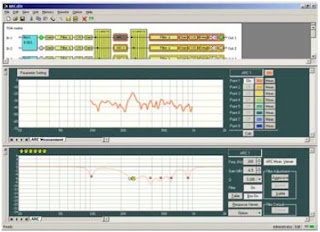First, you should know (if you don’t already) that TOA is not a newcomer to the world of DSP. In fact, TOA introduced the very first, open architecture, multi-function, multi-channel DSP to the Pro/Commercial marketplace. The year was 1988 and the product was the SAORI. What followed was nothing less than a revolution for our industry. Even 25 years later, the SAORI has its fans and many units are still in operation today in venues throughout the world. The DP-K1 is one of the latest in a generation of legacy DSP products, the result of years of development and research by our engineers in Japan.
So what does the DP-K1 do? Well, it shares a modular architecture with other TOA DSP models (such as the D-901 & D-2000), making available a common “library” of Input, Output & Control options. It therefore allows a range of custom configurations (up to 8 In x 8 Out) depending on needs. Inside, the DP-K1 has a compliment of Input processing (Parametric EQ, Filters, Compression, Gate) & Output processing (more Parametric EQ, Filters, Compression, Delay & Crossover), with the ability to matrix inputs to outputs in any combination. While the DP-K1 obviously has ample tools to function primarily as a “back-end” processor for speaker system management, it can actually function as a DSP mixer when necessary (inputs can be set to Mic or Line level and most modules come equipped with preamp gain & phantom power). However, the real power of the DP-K1 comes right between the Inputs & the Outputs. Each of the 8 buses of the DP-K1 comes equipped with an independent Automatic Resonance control (or ARC) processor.
What the ARC processor does is truly unique and would normally require more extensive processing and hours spent by a trained acoustical or sound engineer. The DP-K1 is designed to compensate for resonant nodes which often occur in large acoustic spaces and which have a tendency to negatively impact intelligibility, especially with voice. What does all that techno-babble mean? Well, we’ve all been in a large church or school gymnasium at some point, right? Remember how the sound of the pastor’s voice seemed to ring on forever and you couldn’t make out a word? Or how the sound of bouncing basketballs seemed like a construction site and announcements left you wondering if the home team won or lost (guess that’s why we have scoreboards)? Anyway, that’s due to the hard surfaces and reflected sounds in the space which pile up at certain frequencies to the point where the amount of reflected sound energy exceeds the direct (or desired signal’s) energy. This happens most often at lower and sometimes mid-range frequencies. Not surprisingly, the result is -MUD! Over the years, efforts to solve this acoustic nightmare have yielded some real innovations. Today, line array speaker technology can help to focus the sound energy more directly to the listener and reduce the amount of reflected sound. Sometimes, acoustic treatment can be added to the space to help reduce reflections, though this solution is not always possible (think of a large gothic church) or cost-effective. Through DSP manipulation of the sound output, it is possible to reduce the energy at the frequencies that are the most troublesome. However, in many cases the problem may still persist or the equipment, time and expertise required to effectively resolve it is beyond the reach of most people.

Enter ARC. ARC is a patented TOA technology designed to streamline the process by which this type of solution is applied. By using the simple tools provide by the DP-K1, it’s relatively easy to measure the reverb characteristics (and thereby the resonant nodes) of any given space using just an everyday vocal microphone (no expensive reference mic required). By automatically compiling this data (something the DP-K1s processor does very quickly) it calculates the appropriate equalization curve necessary to reduce the nodal effects of the space and thereby greatly increasing the system’s intelligibility. This all done through the software interface via a networked PC. Up to 8 locations may be measured per ARC processor (allowing you to get the best “average” for the space). Unlike overall room EQ, where factors such as temperature, humidity and occupancy are important, ARC measurements taken when the space is empty and on a cool, dry day will be equally applicable when the room is filled to capacity and the temperature and humidity are much higher. These do not affect the nodal response to any great degree.
In a world flush with DSP products screaming for attention, the DP-K1 stands out as a unique and valuable tool, which should find itself into the arsenal of any sound system designer. Where problems like the ones described above are encountered, the DP-K1 is the solution. ARC processing may also be found in other TOA DSP products, like the M-633D and the new M-864D digital mixers. For a DP-K1 demo (yes, hearing IS believing), please contact your TOA Rep today. For more information visit the DP-K1 webpage by clicking here.



No comments:
Post a Comment